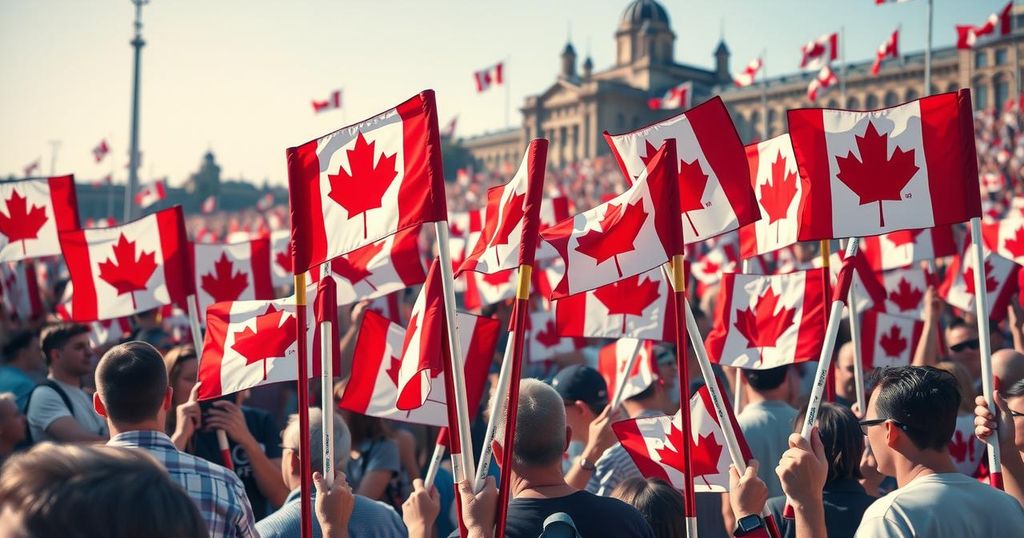Canada’s Political Landscape Transformed Ahead of Historic Election

The Canadian election approaches with a reversal in political fortunes as Mark Carney’s Liberals gain traction against Pierre Poilievre’s Conservatives. Voter frustrations over economic issues and U.S. policies are front and center. Polling indicates a neck-and-neck race, with both parties focusing on national unity amid tariffs. Smaller parties face an uphill battle as support for major parties grows, raising the stakes for this significant election.
A reversal of fortunes is redefining Canada’s political landscape as voters approach the historic election this upcoming Monday. In London, Ontario, a rally for Liberal leader Mark Carney saw supporters voicing their concerns over Donald Trump’s influence, with one chant resonating through the crowd: “Never.” In contrast, Conservative leader Pierre Poilievre is attracting large gatherings, rallying voters to back a call for a change in government defined by Canadian patriotism in light of U.S. tariff threats.
As the campaign unraveled, Trump’s presence looms large. The outcome will likely hinge on which party can convince voters they have a credible strategy to navigate the challenges posed by the American president. National polling indicates a narrow lead for the Liberals, but they are facing tough competition from the Conservatives, who have sought to connect with disaffected voters dissatisfied with the Liberal Party.
The Gionet family from Barrie, Ontario, exemplifies the shifting sentiments of voters. Attending their first political rally, they expressed worries about their daughters’ future home-buying prospects due to rising housing prices. Eric Gionet voiced, “There’s no prospect.” This sentiment of anxiety resonates with many, as opposition parties traditionally capitalize on voter grievances to unseat governments.
In early 2025, the political landscape in Canada was transformed. A string of events, including Justin Trudeau’s resignation and Carney’s ascendancy to the leadership role, significantly shifted voter perceptions. By mid-April, polling showed a dead heat between the Liberal and Conservative parties, giving the once-dormant party newfound hope of winning a fourth consecutive term.
Carney, who famously advised central banks during prior financial crises, is promoting himself as a leader equipped to tackle pressing issues. Yet, responses to this appeal are mixed. Gwendolyn Slover from Prince Edward Island describes his allure as “baffling,” suggesting a skepticism towards the notion that one person could effect real change in the Liberal Party.
Supporters see Carney’s calm demeanor and extensive experience as pivotal, particularly as he navigates threats of tariffs from Trump. His ability to step away from political campaigning and engage directly with U.S. officials has led some to view him as ready for the role of prime minister. With no prior political office experience, Carney is untested, but early campaign performances suggest he wears the pressure well.
Conversely, Poilievre, a seasoned politician, has struggled to assert his party’s narrative amid changing tides in voter preference. His campaign pivoted from fixating on a broken Canada to a more patriotic tone, attempting to distance himself from accusations of emulating Trump’s style. Nevertheless, he has declared, “I have a completely different story from Donald Trump.”
Smaller parties like the NDP and Bloc Québécois have struggled during this campaign, facing dwindling seats in the House of Commons. Both parties historically have served as an opposition force but are now challenged as anxious voters gravitate toward the larger Liberal and Conservative parties. Polls suggest that both leading parties may surpass 38% of votes for the first time since 1975.
The NDP has called for strategic voting in the closing days of the campaign, urging supporters to think critically about their options. Jagmeet Singh emphasized that voters could influence whether Carney secures a supermajority or sufficiently elects New Democrats to advocate for their interests.
This campaign has also laid bare regional divides, focusing heavily on the U.S.-Canada relationship, often sidelining crucial topics like climate change and indigenous reconciliation. Broadly, both frontrunners address the necessity of mitigating dependency on the U.S. while emphasizing economic recovery and workforce protection.
The stakes are high as election day approaches, prompting direct appeals from both candidates. Carney insists that it is “time for experience, not experiments,” while Poilievre counters that Canadians can “choose change on Monday.” The inherent tension highlights the significance of the upcoming decision on not just governance but direction for the future of Canadian society.
Canada’s upcoming election marks a pivotal moment, defined by a dramatic shift in political fortunes. With Mark Carney’s Liberals and Pierre Poilievre’s Conservatives neck-and-neck, the candidates are addressing voter anxieties and future leadership styles. Challenging issues, such as the impact of U.S. policies and internal party dynamics, are driving voter sentiment. As the election looms, the country stands at a crossroads, with significant implications for Canada’s political and economic future.
Original Source: www.bbc.com








